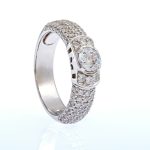As a proud owner of a Mitsubishi Eclipse, you may often wonder, “How can I enhance my vehicle’s performance and engine longevity?” One answer that might come up frequently in your research is the use of a racing-grade timing belt. This simple yet crucial component might be the key to unlocking your vehicle’s potential and extending its lifespan. But is the upgrade worth it? Could it really lead to significant improvements and benefits for your Mitsubishi Eclipse’s engine longevity?
Let’s unravel this discussion through an in-depth look at the importance of the timing belt, benefits of upgrading to a racing-grade version, considerations before making the upgrade and how it directly impacts the longevity of your Mitsubishi Eclipse’s engine.
Cela peut vous intéresser : How to Calibrate the Adaptive Front Lighting System on an Audi Q5 for Perfect Road Illumination?
The Importance of the Timing Belt in Your Vehicle’s Engine
The timing belt – a toothed, high-tensile-strength belt – is a critical component of your vehicle’s engine. It synchronizes the crankshaft and camshaft’s rotation, ensuring that engine valves open and close at the precise time during each cylinder’s intake and exhaust strokes. This synchronization is essential for your engine to run smoothly and efficiently.
A failing timing belt can cause severe engine damage, leading to costly repairs, or at worst, necessitating a complete engine replacement. Maintaining and, when necessary, upgrading your timing belt, can thus significantly contribute to your Mitsubishi Eclipse’s engine longevity.
Avez-vous vu cela : Create raised garden beds to optimise your garden
Benefits of Upgrading to a Racing-Grade Timing Belt
A racing-grade timing belt, as the name suggests, is a higher specification version of a standard timing belt, designed to withstand the rigors of high-performance racing engines. Incorporating such a belt into your Mitsubishi Eclipse could offer a number of benefits.
Firstly, a racing-grade timing belt is more robust and durable than a standard timing belt. It’s built to resist extreme temperatures and pressures, making it less likely to fail or wear out prematurely.
Secondly, the improved strength and durability of a racing-grade belt significantly reduce the risk of snap, stretch, or wear that could damage the engine. Consequently, this can lead to extended engine life, allowing you to enjoy your Mitsubishi Eclipse for a longer period.
Considerations Before Upgrading Your Timing Belt
Although the benefits of a racing-grade timing belt are appealing, it’s important to carefully consider a few things before deciding to upgrade.
First off, consider your driving style. If you frequently push your vehicle to high speeds, a racing-grade timing belt might be a necessity. On the other hand, if your Mitsubishi Eclipse is primarily used for everyday, casual driving, a standard timing belt may suffice.
Furthermore, the condition of your current timing belt should also be assessed. If it’s still in good shape, upgrading may not be immediately necessary. However, if there are signs of wear and tear, upgrading sooner than later could prevent potential engine damage.
How a Racing-Grade Timing Belt Improves Engine Longevity
Now for the crux of the matter: how does a racing-grade timing belt directly contribute to your Mitsubishi Eclipse’s engine longevity?
The primary factor is the enhanced durability of the racing-grade timing belt. By resisting wear and tear, it minimizes the risk of a snapped belt causing engine damage.
Secondly, a racing-grade timing belt can better handle heat and friction, two factors that significantly affect engine longevity. By efficiently withstanding these conditions, the belt ensures that the engine runs smoothly, reducing wear on other components and contributing to overall engine health.
Lastly, high-quality timing belts often result in improved engine performance. They can handle higher engine loads, allowing for smoother acceleration and less strain on the engine during high-speed driving. This improved performance contributes to engine longevity by reducing the overall stress on the engine components.
In the final analysis, upgrading to a racing-grade timing belt can indeed benefit your Mitsubishi Eclipse’s engine longevity. The enhanced durability and performance of these belts provide a buffer against wear and tear, heat, and friction that can compromise the lifespan of your engine. However, it’s also crucial to consider your driving habits and the condition of your current timing belt before making the upgrade. Consult with a trusted mechanic to make an informed decision that will keep your Mitsubishi Eclipse running smoothly for years to come.
The Impact of Racing-Grade Timing Belt on Engine Performance
An engine’s performance is largely dependent on the quality of its key components, and the timing belt is no exception. If you’re an ambitious driver, continually pushing your Mitsubishi Eclipse to its limits, you’re going to need an equally ambitious timing belt—a racing-grade timing belt.
Racing-grade timing belts are engineered to withstand high-demand driving circumstances. They are created to resist extreme temperatures and pressures, which are often encountered during high-speed driving or racing. This resistance to harsh conditions ensures that they do not easily wear out or snap, a common issue with standard timing belts when subjected to high-stress driving situations.
Moreover, the superior quality of these belts translates into improved engine performance. They are specifically designed to handle higher engine loads, enabling smoother acceleration and minimizing strain on the engine during high-speed driving conditions. This not only enhances the overall driving experience but also contributes to the longevity of the engine by reducing the overall stress on its components.
Therefore, if you’re someone who likes to unleash the full potential of your Mitsubishi Eclipse, upgrading to a racing-grade timing belt can undoubtedly enhance the performance and lifespan of your engine.
Conclusion: Is Upgrading to a Racing-Grade Timing Belt Worth it?
In conclusion, the decision to upgrade to a racing-grade timing belt can significantly affect the longevity and performance of your Mitsubishi Eclipse’s engine. The enhanced durability and robustness of these belts can provide a buffer against wear and tear, heat, and friction that can compromise the lifespan of your engine.
However, this decision should not be taken lightly. It’s crucial to take into account your driving habits and the condition of your current timing belt. If you’re frequently pushing your vehicle to high speeds, the upgrade may be a necessity. However, if your driving style leans more towards everyday, casual use, a standard timing belt might suffice.
Regardless of the choice you make, remember to regularly maintain your timing belt. Regular inspections can help identify any signs of wear or potential issues, allowing you to address them before they escalate into serious problems.
Consulting with a trusted mechanic is always a good idea before making any major changes to your vehicle. They can provide expert advice tailored to your specific circumstances, helping you make an informed decision that will benefit the longevity and performance of your Mitsubishi Eclipse’s engine.
Remember, your vehicle is an investment, and like any good investment, it should be well-maintained and taken care of. Upgrading to a racing-grade timing belt could be a step in the right direction towards enhancing your vehicle’s performance and extending its lifespan. After all, your Mitsubishi Eclipse deserves nothing but the best.






